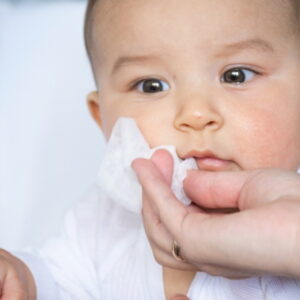Mom’s Question:
My five-month-old little girl has a fused labia, not from birth but because of adhesion caused by diaper rash. I found out at three months but it keeps reattaching. I am so frustrated.
What do I do to keep it separated? I used Premarin but it does not seem to work for her. Also plenty of A+D Ointment.
What else can I do?
Renee
Baby Helpline:
Causes And Treatments Of Fused Labia In Baby
Causes Of Fused Labia
Fused labia is not something you typically know about or even hear about before encountering in real life, but it is more common in baby girls than one might think.
Most newborn babies have their labia separated, but as estrogen levels fall a few months after birth, the labia may become stuck together.
The trigger may be a skin irritation or nappy rash, but the underlying cause is the naturally low level of estrogen in young babies.
Possible Complications
In most cases, the labial adhesions will not affect the baby at all. They cause no harm beyond the worrying that the parents may go through.
Sometimes, especially if the labia are almost completely shut, urine can get trapped, causing irritation, urinary tract infections and later on, make potty training more difficult, because there will be a leakage after the toddler is done – confusing for the child!
But these complications are exceptions. If your baby isn’t experiencing any problems, then there are no reasons for concerns.
Treatments For Labial Adhesions
As I said, fused labia is caused by the naturally low levels of estrogen in young babies. As estrogen levels rise when the girl grows older, the labia will separate without any treatment at all. The adhesions will disappear naturally for most girls at some point; often after 6 years of age or at least at the onset of puberty.
The most common treatment is to apply an estrogen cream. For most babies (but not all), this will help to separate the labia within a couple of weeks. This treatment is slightly controversial, though. One thing is that the labia may very well become shut again when you stop applying the cream. There are also potential side effects of the cream – slight breast growth and pubic hair.
More and more pediatricians will not treat fused labia at all since it is of no harm in most cases.
A rule of thumb is to only prescribe estrogen creams when the labial adhesions cover more than 50% of the opening. If the cream is successfully used to separate the labia, the following should be done to keep them separated:
- Make sure to clean not only the outer but also the inner labia with water every day, since many doctors have observed that keeping the area clean will prevent the adhesions. No soap though!
- Make sure to gently separate the labia at least once per day at the diaper change, to keep them separated.
- Apply vaseline with a q-tip to the labia once per day.
- There is also a concern among doctors that diapers (through moist, darkness, and bacteria) contribute to the adhesions. There are no studies verifying this as far as I know, but it will certainly not do any harm to let your baby kick around without diapers as much as possible.
The above tips can probably prevent adhesions to occur in the first place too.
Also do not use soap if you bathe your baby. Babies usually become clean only with water or with a few drops of organic baby oil in the water.
Never ever try to try to force the labia open! It is painful and the labia will become fused again anyway.
For babies and children where the adhesions are causing problems and the estrogen cream doesn’t help, the labia may be separated under anesthesia.
I hope this helps,
Paula
(Answer approved by our Medical Reference Team)
More Questions Related To The Diaper Area
- Blood In Baby Girl’s Diaper
- Why Is My Baby Grabbing Her Private Parts?
- Yellow Discharge For 9 Month Baby’s Vagina
Find comments below.
Comments |
||
|
||
| We have changed to a new commenting system. Add your comments below. |

Paula Dennholt founded Easy Baby Life in 2006 and has been a passionate parenting and pregnancy writer since then. Her parenting approach and writing are based on studies in cognitive-behavioral models and therapy for children and her experience as a mother and stepmother. Life as a parent has convinced her of how crucial it is to put relationships before rules. She strongly believes in positive parenting and a science-based approach.
Paula cooperates with a team of pediatricians who assist in reviewing and writing articles.




